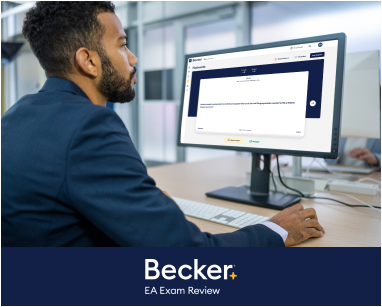
Ready to enhance your tax career? Learn how to become an Enrolled Agent (EA) to expand your job opportunities and help clients resolve tax issues.
Earning your EA designation takes some time and hard work but is very attainable with dedication and guidance. Understand how to become an Enrolled Agent, and achieve your career goals through EA Exam preparation and continuing education.
How to become an Enrolled Agent |
What is an Enrolled Agent?
An Enrolled Agent (EA) is a qualified tax professional who has earned the legal right to represent clients on their tax matters before the IRS.
An Enrolled Agent designation is the highest tax representation authority granted by the IRS, allowing you to:
- Prepare and file taxes.
- Represent clients before the IRS, whether or not you filed their taxes.
- Respond to IRS communications on behalf of clients.
- Appeal a ruling.
- Assist with an audit.
As a federal designation, EAs can practice anywhere in the US without limitations as to who they can represent or which type of tax matters they can handle.
How to become an Enrolled Agent
To become an Enrolled Agent, you must plan and study. But with the right guidance, many EAs go through the entire process in just one year, sometimes even less.1
1. Get your Preparer Tax Identification Number (PTIN)
The first step to become an Enrolled Agent is applying for and receiving your Preparer Tax Identification Number (PTIN). Anyone paid to prepare tax returns needs this IRS-issued ID number.
You can apply for a PTIN online through the IRS.gov website, or by snail mail through the IRS PTIN processing center in San Antonio, Texas. It takes about 15 minutes to apply and costs $19.75.2
Normally, it takes about four to six weeks processing time to receive your PTIN.3
2. Pass the EA Exam
The Special Enrollment Examination (SEE), or more commonly EA Exam, is a three-part exam testing all things tax preparation and representation. Passing this comprehensive exam is necessary to become an Enrolled Agent, demonstrating that you are prepared with the knowledge and skills to work in this role.
The EA Exam includes three separate parts that you must pass within a maximum three-year period:
- Part 1: Individuals
- Part 2: Businesses
- Part 3: Representation, Practices, and Procedures
Each exam part contains 100 multiple-choice questions, with 3.5 hours (and an optional 15-minute break) to complete them.
Exams are graded using scaled scoring, with a max score of 130. You must score at least 105 to pass. You’ll receive your score immediately after completing the exam. If you've passed, the report will show a passing designation. If you fail, you will see your score (from 40-104), with a diagnostic indicator in each topic area to help you hone your study.4
You can retake each exam part up to four times within each testing window; however, at $259 per test, it is important to invest in a great exam review so you are fully prepared and confident to pass on the first try.
3. Apply for enrollment
Once you’ve passed all three EA Exam sections, your path to becoming an Enrolled Agent is close to completion!
You must finally apply for enrollment. The IRS will conduct a “suitability check” that includes a criminal background check and tax compliance investigation to ensure that you have no outstanding tax liabilities.
To apply, fill out Form 23 found on the IRS.gov website and pay the $140 application fee. Processing is normally completed within 60 days of your application.5
How to maintain your Enrolled Agent designation
You must fulfill certain requirements to keep your hard-earned Enrolled Agent designation active and in good standing.
EA designation renewal
You must renew your EA designation every three years, based on the last digit of your social security number. You complete renewal by filling out the IRS's Form 8554 and paying the $140 renewal fee.6
Continuing education (CE) requirements
Maintaining your designation also requires that you meet the EA CE requirements:
- 72 hours of continuing education (CE) credits over the course of each three-year renewal cycle
- At least 16 hours of CE per year
- 2 hours of ethics per year
But Enrolled Agent CE is about more than just meeting requirements. The right courses can help you build new skills and stay aware of changes and updates to tax codes and laws!
PTIN renewal
You must renew your PTIN annually, from mid-October through December 31. You do this by accessing your IRS.gov account, completing the online renewal form, and paying the $19.75 renewal fee.2
Try Becker's EA Exam Review FREE for 14 days
If you’re ready to become an Enrolled Agent, Becker can help you achieve your goals with our new EA Exam Review! Like our CPA Exam Review course, our EA Exam Review includes everything you need to get Exam Day ReadySM. Try it FREE for 14 days and see how we help you meet your career goals.
- https://www.miamiherald.com/careers-education/how-long-does-it-take-to-become-an-enrolled-agent/#:~:text=Typically%2C%20the%20path%20to%20becoming,as%20enforced%20by%20the%20Irs.
- https://www.irs.gov/tax-professionals/ptin-requirements-for-tax-return-preparers
- https://www.taxpayeradvocate.irs.gov/get-help/general/getting-a-ptin/#:~:text=PTIN%20applications%20for%20the%20upcoming,in%20mid%2DOctober%20each%20year.&text=Mailed%20applications%20take%20about%20four,(PTIN)%20Application%20and%20Renewal.
- https://www.prometric.com/sites/default/files/IRS/IRS-SEE-Candidate-Information-Bulletin.pdf
- https://www.irs.gov/tax-professionals/enrolled-agents/applying-for-enrollment-to-practice-before-the-irs
- https://www.irs.gov/tax-professionals/enrolled-agents/maintain-your-enrolled-agent-status








